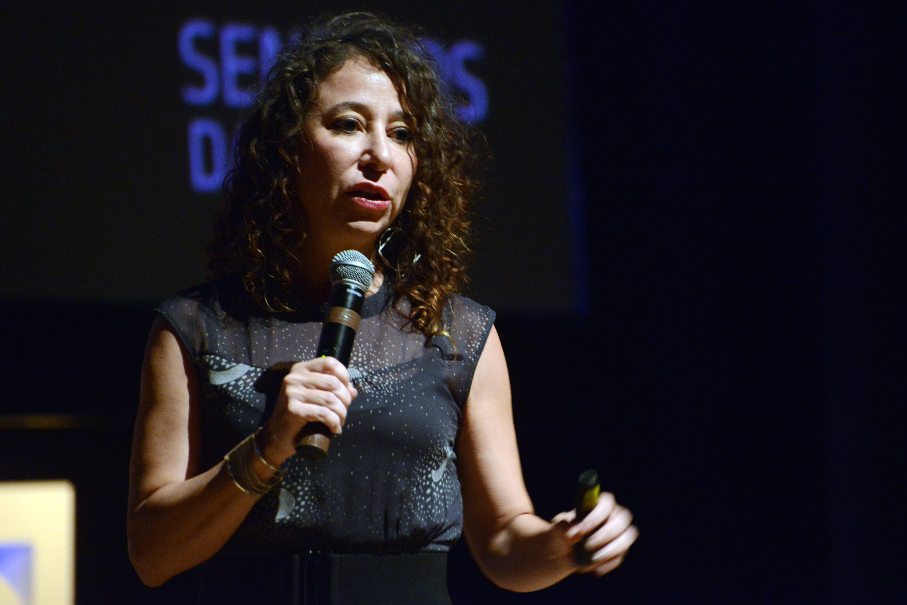|
By Manasi Sharma
Intelligent, astute, and, in her own words, “greedy for life experiences,” Dr. Janna Levin is one of the most engaging and well-known scientists on campus. As a Professor of Physics and Astronomy at Barnard College and a recipient of the Tow Professor grant, Dr. Levin’s main research focuses are the early universe, chaos, and black holes. She is also the author of popular science novels such as How the Universe Got Its Spots: Diary of a Finite Time in a Finite Space (2002),A Madman Dreams of Turing Machines (2006), and most recently, Black Hole Blues and Other Songs from Outer Space (2016). Dr. Levin has also appeared on many shows, including this past January as a host on the Nova's award-winning episode “Black Hole Apocalypse.” Many of us on campus might also know her as a lecturer for the Astrophysics unit in Columbia College’s Frontiers of Science seminar. Dr. Levin sat down to chat with me earlier this year about topics ranging from her past work on universe topology to her scientific pursuits outside of research. In short, she says, “I’m particularly interested in general relativity—the suggestion that space and time warp and stretch in response to mass and energy. Everything I work on has to do with that: the Big Bang, the shape of space and time, black holes.” When I asked her about what she has been working on most recently, Dr. Levin excitedly introduced her favorite topic—black holes. “As of late, I’ve been more focused on black holes and part of that is because of this incredible discovery that won the Nobel Prize in 2017.” (She is referring, of course, to the monumental discovery of gravitational waves in February 2016, which were produced by the merger of two black holes millions of years ago.) “It’s weird to think about it,” she tells me, “but black holes are like the fundamental particle of gravity, almost like electrons. They are the wildest, most extreme objects in the universe.” Dr. Levin has done extensive work on the dynamics of black hole mergers and whether or not electromagnetic radiation is released during the mergers. The recent discovery of the neutron-star merger in 2017 really kickstarted Dr. Levin’s work on black holes, as they provide experimental counterparts to the theoretical background she works on. “It’s always good to work on something and then have it be observed in some manner,” she told me. Professor’s Levin’s work includes analysis of extra-spatial dimensions, which lie outside the normal three dimensions of length, width, and height. According to Dr. Levin, “extra-spatial dimensions might be topologically finite—you could imagine them being wrapped up like origami. In this case, all the dimensions in the universe should be finite. The question then arises of how the regular three got to be so big.” She went on to say that studying these smaller dimensions could give you an idea of whether the universe is finite or infinite. “It’s a question that might be unanswerable, and that’s one of the reasons that I wrote [How the Universe Got Its Spots] because I wasn’t sure if anyone could ever figure it out. I wanted to keep the idea alive.” When prompted about any future plans or collaborations, Dr. Levin told me that she teams up with other researchers from around the world. “I have collaborators in Georgia, Harvard, Oxford, et cetera, although admittedly, it’s hard to collaborate over long-distance,” she told me with a laugh. She also mentioned her current and future work with Columbia Professor Brian Greene, with whom she has done some “really good work on extra-spatial dimensions—specifically, how to combine string theory and cosmology.” With regard to future plans, she mentioned that she sits down every few years to reflect on what she has done so far and where she wants to go in the coming years. I was curious to know what her daily schedule looked like. She told me that she divides her time between these different pursuits and that she doesn’t have a set pattern because her time is largely dependent on her academic schedule. However, she is a strong proponent for the strategy of dividing tasks or committing to things in chunks. She tells me that, “I can’t fit everything in in one day, so I try to assign days to certain tasks—I have my writing days, my Barnard/Columbia days, and so on, and in those days, I’m absolutely dedicated to those individual tasks… I’ve noticed that that tends to work best.” In addition to her research, Professor Levin is currently teaching Barnard’s introductory physics sequence, as well as working on an upcoming book. She is also the Director of Sciences at Pioneer Works, a non-profit foundation that seeks to foster multidisciplinary creativity in the arts and sciences. Between her mind-boggling research, best-selling books, and on-campus lectures, Professor Levin’s status as an accessible campus figure belies the true breadth of her accomplishments. At the same time that she explains the basic tenets of general relativity to a room of tired first-years, she studies the multi-dimensional universe and the enigma of its black holes. Professor Levin is proof that in brilliance and approachability are not necessarily mutually exclusive, and that the beauty of science lies in its appeal to every level of expertise -- from bleary-eyed high school graduates to award-winning physics geniuses.
1 Comment
Leave a Reply. |
Categories
All
Archives
April 2024
|

